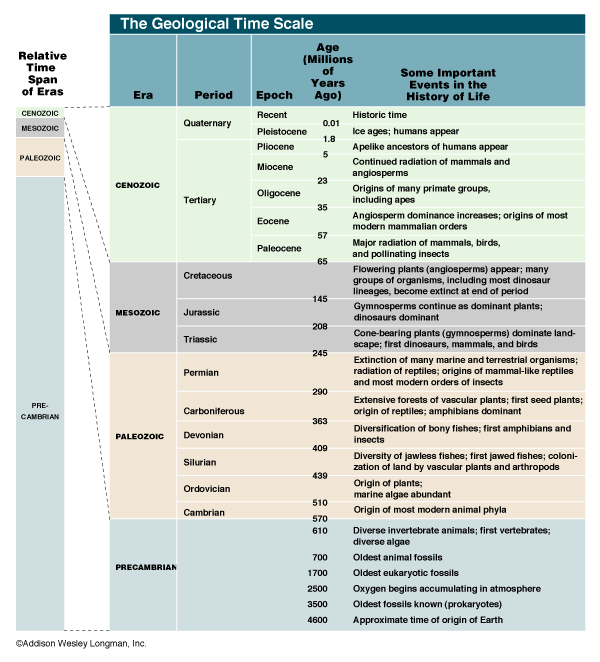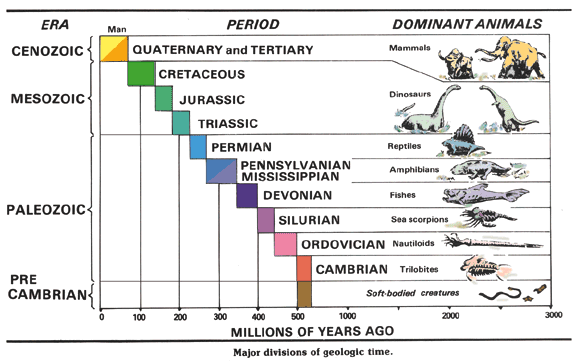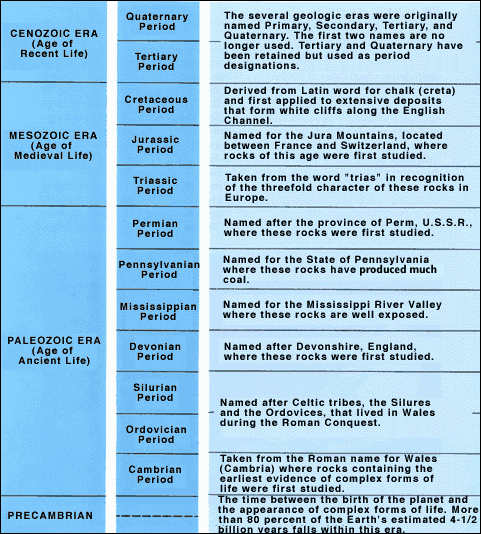http://evolution.berkeley.edu/evosite/evohome.html


Three main types of subdivisions of geologic time
Eras:
Are major subdivisions of the geologic time scale and are based on differences of life forms.
Periods: Based on the type of life existing at the time and on major geologic events like mountain building and plate tectonic movement.
Epochs:
Based on more specific and shorter time periods of life and geologic events.
Based on more specific and shorter time periods of life and geologic events.
Species:
A group of individuals that breed among themselves to make offspring.
Natural Selection:
The process by which living organisms with traits best suited to an environment survive, while others die out because they lack those desirable traits.
This table is not to any scale.)
| Eon | Era | Period[1] | Series/ Epoch | Major Events | Start, Million Years Ago[2] | |
|---|---|---|---|---|---|---|
| Phane- rozoic | Cenozoic | Neogene[3] | Holocene | End of recent glaciation and rise of modern civilization. | 0.011430 | |
| Pleistocene | Flourishing and then extinction of many large mammals (Pleistocene megafauna). Evolution of anatomically modern humans. | 1.806 * | ||||
| Pliocene | Intensification of present ice age; cool and dry climate. Australopithecines, many of the existing genera of mammals, and recent mollusks appear. Homo habilis appears. | 5.332 * | ||||
| Miocene | Moderate climate; Orogeny in northern hemisphere. Modern mammal and bird families became recognizable. Horses and mastodons diverse. Grasses become ubiquitous. First apes appear. | 23.03 * | ||||
| Paleogene [3] | Oligocene | Warm climate; Rapid evolution and diversification of fauna, especially mammals. Major evolution and dispersal of modern types of flowering plants | 33.9 * | |||
| Eocene | Archaic mammals (e.g. Creodonts, Condylarths, Uintatheres, etc) flourish and continue to develop during the epoch. Appearance of several "modern" mammal families. Primitive whales diversify. First grasses. Reglaciation of Antarctica; current ice age begins. | 55.8 * | ||||
| Paleocene | Climate tropical. Modern plants appear; Mammals diversify into a number of primitive lineages following the extinction of the dinosaurs. First large mammals (up to bear or small hippo size). | 65.5 * | ||||
| Mesozoic | Cretaceous | Upper/Late | Flowering plants proliferate, along with new types of insects. More modern teleost fish begin to appear. Ammonites, belemnites, rudist bivalves, echinoids and sponges all common. Many new types of dinosaurs (e.g. Tyrannosaurs, Titanosaurs, duck bills, and horned dinosaurs) evolve on land, as do modern crocodilians; and mosasaurs and modern sharks appear in the sea. Primitive birds gradually replace pterosaurs. Monotremes, marsupials and placental mammals appear. Break up of Gondwana. | 99.6 * | ||
| Lower/Early | 145.5 | |||||
| Jurassic | Upper/Late | Gymnosperms (especially conifers, Bennettitales and cycads) and ferns common. Many types of dinosaurs, such as sauropods, carnosaurs, and stegosaurs. Mammals common but small. First birds and lizards. Ichthyosaurs and plesiosaurs diverse. Bivalves, Ammonites and belemnites abundant. Sea urchins very common, along with crinoids, starfish, sponges, and terebratulid and rhynchonellid brachiopods. Breakup of Pangea into Gondwana and Laurasia. | 161.2 | |||
| Middle | 175.6 * | |||||
| Lower/Early | 199.6 | |||||
| Triassic | Upper/Late | Archosaurs dominant on land as dinosaurs, in the oceans as Ichthyosaurs and nothosaurs, and in the air as pterosaurs. cynodonts become smaller and more mammal-like, while first mammals and crocodilia appear. Dicrodium flora common on land. Many large aquatic temnospondyl amphibians. Ceratitic ammonoids extremely common. Modern corals and teleost fish appear, as do many modern insect clades. | 228.0 | |||
| Middle | 245.0 | |||||
| Lower/Early | 251.0 * | |||||
| Paleozoic | Permian | Lopingian | Landmasses unite into supercontinent Pangea, creating the Appalachians. End of Permo-Carboniferous glaciation. Synapsid reptiles (pelycosaurs and therapsids) become plentiful, while parareptiles and temnospondyl amphibians remain common. In the mid-Permian, coal-age flora are replaced by cone-bearing gymnosperms (the first true seed plants) and by the first true mosses. Beetles and flies evolve. Marine life flourishes in warm shallow reefs; productid and spiriferid brachiopods, bivalves, forams, and ammonoids all abundant. Permian-Triassic extinction event occurs 251 mya: 95 percent of life on Earth becomes extinct, including all trilobites, graptolites, and blastoids. | 260.4 * | ||
| Guadalupian | 270.6 * | |||||
| Cisuralian | 299.0 * | |||||
| Carbon- iferous[4]/ Pennsyl- vanian | Upper/Late | Winged insects radiate suddenly; some (esp. Protodonata and Palaeodictyoptera) are quite large. Amphibians common and diverse. First reptiles and coal forests (scale trees, ferns, club trees, giant horsetails, Cordaites, etc.). Highest-ever oxygen levels. Goniatites, brachiopods, bryozoa, bivalves, and corals plentiful in the seas. Testate forams proliferate. | 306.5 | |||
| Middle | 311.7 | |||||
| Lower/Early | 318.1 * | |||||
| Carbon- iferous[4]/ Missis- sippian | Upper/Late | Large primitive trees, first land vertebrates, and amphibious sea-scorpions live amid coal-forming coastal swamps. Lobe-finned rhizodonts are big fresh-water predators. In the oceans, early sharks are common and quite diverse; echinoderms (esp. crinoids and blastoids) abundant. Corals, bryozoa, goniatites and brachiopods (Productida, Spiriferida, etc.) very common. But trilobites and nautiloids decline. Glaciation in East Gondwana. | 326.4 | |||
| Middle | 345.3 | |||||
| Lower/Early | 359.2 * | |||||
| Devonian | Upper/Late | First clubmosses, horsetails and ferns appear, as do the first seed-bearing plants (progymnosperms), first trees (the tree-fern Archaeopteris), and first (wingless) insects. Strophomenid and atrypid brachiopods, rugose and tabulate corals, and crinoids are all abundant in the oceans. Goniatite ammonoids are plentiful, while squid-like coleoids arise. Trilobites and armoured agnaths decline, while jawed fishes (placoderms, lobe-finned and ray-finned fish, and early sharks) rule the seas. First amphibians still aquatic. "Old Red Continent" of Euramerica. | 385.3 * | |||
| Middle | 397.5 * | |||||
| Lower/Early | 416.0 * | |||||
| Silurian | Pridoli | First vascular plants (the whisk ferns and their relatives), first millipedes and arthropleurids on land. First jawed fishes, as well as many armoured jawless fish, populate the seas. Sea-scorpions reach large size. Tabulate and rugose corals, brachiopods (Pentamerida, Rhynchonellida, etc.), and crinoids all abundant. Trilobites and mollusks diverse; graptolites not as varied. | 418.7 * | |||
| Upper/Late (Ludlow) | 422.9 * | |||||
| Wenlock | 428.2 * | |||||
| Lower/Early (Llandovery) | 443.7 * | |||||
| Ordovician | Upper/Late | Invertebrates diversify into many new types (e.g., long straight-shelled cephalopods). Early corals, articulate brachiopods (Orthida, Strophomenida, etc.), bivalves, nautiloids, trilobites, ostracods, bryozoa, many types of echinoderms (crinoids, cystoids, starfish, etc.), branched graptolites, and other taxa all common. Conodonts (early planktonic vertebrates) appear. First green plants and fungi on land. Ice age at end of period. | 460.9 * | |||
| Middle | 471.8 | |||||
| Lower/Early | 488.3 * | |||||
| Cambrian | Upper/Late (Furongian) | Major diversification of life in the Cambrian Explosion. Many fossils; most modern animal phyla appear. First chordates appear, along with a number of extinct, problematic phyla. Reef-building Archaeocyatha abundant; then vanish. Trilobites, priapulid worms, sponges, inarticulate brachiopods (unhinged lampshells), and many other animals numerous. Anomalocarids are giant predators, while many Ediacaran fauna die out. Prokaryotes, protists (e.g., forams), fungi and algae continue to present day. Gondwana emerges. | 501.0 * | |||
| Middle | 513.0 | |||||
| Lower/Early | 542.0 * | |||||
| Proter- ozoic [5] | Neo- proterozoic | Ediacaran | Good fossils of multi-celled animals. Ediacaran fauna (or Vendobionta) flourish worldwide in seas. Trace fossils of worm-like Trichophycus, etc. First sponges and trilobitomorphs. Enigmatic forms include oval-shaped Dickinsonia, frond-shaped Charniodiscus, and many soft-jellied creatures. | 630+5/-30 * | ||
| Cryogenian | Possible "snowball Earth" period. Fossils still rare. Rodinia landmass begins to break up. | 850 [6] | ||||
| Tonian | Rodinia supercontinent persists. Trace fossils of simple multi-celled eukaryotes. First radiation of dinoflagellate-like acritarchs. | 1000 [6] | ||||
| Meso- proterozoic | Stenian | Narrow highly metamorphic belts due to orogeny as supercontinent Rodinia is formed. | 1200 [6] | |||
| Ectasian | Platform covers continue to expand. Green algae colonies in the seas. | 1400 [6] | ||||
| Calymmian | Platform covers expand. | 1600 [6] | ||||
| Paleo- proterozoic | Statherian | First complex single-celled life: protists with nuclei. Columbia is the primordial supercontinent. | 1800 [6] | |||
| Orosirian | The atmosphere became oxygenic. Vredefort and Sudbury Basin asteroid impacts. Much orogeny. | 2050 [6] | ||||
| Rhyacian | Bushveld Formation occurs. Huronian glaciation. | 2300 [6] | ||||
| Siderian | Oxygen Catastrophe: banded iron formations result. | 2500 [6] | ||||
| Archean [5] | Neoarchean | Stabilization of most modern cratons; possible mantle overturn event. | 2800 [6] | |||
| Mesoarchean | First stromatolites (probably colonial cyanobacteria). Oldest macrofossils. | 3200 [6] | ||||
| Paleoarchean | First known oxygen-producing bacteria. Oldest definitive microfossils. | 3600 [6] | ||||
| Eoarchean | Simple single-celled life (probably bacteria and perhaps archaea). Oldest probable microfossils. | 3800 | ||||
| Hadean [5][7] | Lower Imbrian[8] | c.3850 | ||||
| Nectarian[8] | c.3920 | |||||
| Basin Groups[8] | Oldest known rock (4100 mya). | c.4150 | ||||
| Cryptic[8] | Formation of earth (4570 mya). Oldest known mineral (4400 mya). | c.4570 | ||||




No comments:
Post a Comment
Note: Only a member of this blog may post a comment.